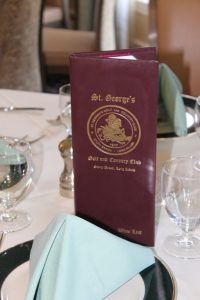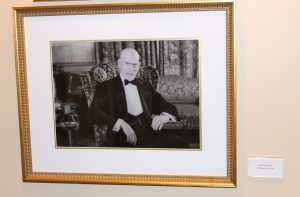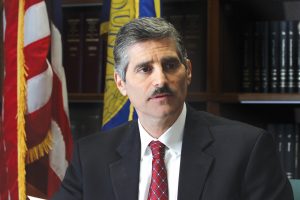A friend of  famed golf course architect Devereaux Emmet once remarked, “Emmet could not possibly conceive of any other use [for] any given piece of real estate…except to lay out golf links on it.” And so, when Emmet and a group of NYC businessmen purchased 140 acres of land in East Setauket in 1915, that’s exactly what he did. Over 100 years later, St. George’s Golf and Country Club – the course Emmet designed for his closest friends and relatives to enjoy – boasts his original timeless design, repeatedly earning a coveted spot on Golfweek’s Top 100 Classic Courses in America (sharing the honor with some of the most famous courses in the nation). If you’re looking for a hidden gem among Long Island golf courses – as well as close friendships, a family atmosphere, business opportunities, impeccable service, and the best steak anywhere – St. George’s checks all the boxes.
famed golf course architect Devereaux Emmet once remarked, “Emmet could not possibly conceive of any other use [for] any given piece of real estate…except to lay out golf links on it.” And so, when Emmet and a group of NYC businessmen purchased 140 acres of land in East Setauket in 1915, that’s exactly what he did. Over 100 years later, St. George’s Golf and Country Club – the course Emmet designed for his closest friends and relatives to enjoy – boasts his original timeless design, repeatedly earning a coveted spot on Golfweek’s Top 100 Classic Courses in America (sharing the honor with some of the most famous courses in the nation). If you’re looking for a hidden gem among Long Island golf courses – as well as close friendships, a family atmosphere, business opportunities, impeccable service, and the best steak anywhere – St. George’s checks all the boxes.
Devereaux Emmet observed the building of the celebrated National Golf Links of America in Southampton, and golfers can feel the similarities at St. George’s, says General Manager Brian Curtin. Curtin may be partial, but Golfweek agrees, first bestowing the honor of Top 100 Classic Courses in America on St. George’s in 2011 and every year since – a remarkable recognition given that there are approximately 6,000 classic courses in the United States (built before 1960). St. George’s prioritizes the pace of play, offering the ability to play a round in a reasonable amount of time (two and a half to three hours for a twosome, four hours or less for a foursome). Tee times aren’t required – another unique feature – and the club offers tournaments for players of all skill levels (the Junior PGA League, ages six to 12, recently won the Long Island championship). St. George’s is fortunate to have dynamic instructors and mentors in Head Golf Pro Chris Crenshaw and First Assistant Golf Pro Nick Banks, who make it their mission to adapt to each student’s learning style.
While the golf gets top billing, the dining experience merits its own spotlight. Head Chef Bill Kakavas has created delicious meals at St. George’s for the past 25 years, getting to know the members and their palates. His seasonal menus feature a blend of traditional comfort food (a 24-ounce T-bone steak) and modern food trends (Mediterranean branzino filet with stewed zucchini) to appeal to a multi-generational membership. Dinner is served Wednesdays, Fridays, and Sundays from April to January 2, and the newly added pub menu on the other evenings has been a huge success.
Members rave about the dedicated staff, headed by Food and Beverage Manager Joelle Battelli. She encourages bartenders to get creative; members can try something new with the cocktail of the day. Reflecting the club’s commitment to creating custom-tailored experiences, members help curate the wine list and enjoy the use of the club for private events for family celebrations, office parties, and golf outings. CMM’s Joe Campolo, who joined St. George’s in 2012, pointed out, “With such a great resource, why go to another restaurant?”

Frank Morgigno, CEO of Applied Technologies of NY, President of St. George’s since last fall, has prioritized initiatives to welcome the new members who represent the club’s future. His efforts are paying off: in the past year, the majority of new families are junior members (through age 39). A variety of memberships at different price points appeal to a diverse membership; family, individual, and weekday memberships are offered, and even a “social” membership for those who don’t golf. Indeed, there’s plenty to keep you busy at St. George’s even if you’re not a golfer. The House Committee plans a packed calendar every year featuring the traditional St. Patrick’s Day Party and Labor Day Clam Bake to new events such as Motown Night, Hawaiian Luau, and Western Night. The recent addition of yoga has been a hit, and under Morgigno’s leadership, the board is exploring plans for a new fitness center, bocce ball and tennis courts, a fire pit, and day care services.
At this exciting time in the life of the club, General Manager Brian Curtin is responsible for the clubhouse, pro shop, and office staff. As a teenager he worked in kitchens as a dishwasher and after college worked his way up, working two stints at Shinnecock Hills Golf Club (first as Banquet Manager and then as Sous Chef), at Lido Golf Club (Executive Chef), owning his own catering business, and serving as General Manager at Great Rock Golf Club before joining St. George’s as General Manager in 2016. Members and staff agree that his deep level of experience has already made an extraordinary impact.
With all the club options on Long Island, why St. George’s? As Curtin recently explained, it’s truly a hidden jewel. “To see the excitement of people when they’re here… we take great pride in that,” he says, as well as in the attention to detail of the department heads and staff, all of whom make a point to get to know new members right away and make them feel welcome. Social and business opportunities also abound: as Morgigno explains, “It’s not cliquey – everyone is friendly. You’ll develop great relationships and find someone to play with.”
Learn more at http://www.stgeorgesgolf.com/Home.aspx.


Joe Campolo, St. George’s President Frank Morgigno, and General Manager Brian Curtin enjoy the fresh air on the spacious back deck. Next photo: St. George’s Golf and Country Club was designed by pioneering golf course architect Devereux Emmet in 1915. According to Golf Club Atlas, “This was going to be [Emmet’s] course for his friends and relatives and he spent his time getting it right. St. George’s defining characteristic is startlingly unique holes on American soil.”


The bar is a welcoming spot to catch up with friends and build new relationships. Bartenders are encouraged to get creative with unique “cocktails of the day.”


Joe Campolo and Brian Curtin enjoy the sunshine and the view. Next photo: St. George’s Golf and Country Club formally opened on June 23, 1917 with an exhibition amateur-professional match to benefit the Red Cross. Over 100 years later, St. George’s still features the same original design.


Recent restoration projects to the links style course, including tree removal, fairway expansion, and asphalt cart path removal, beautified the grounds and honored the original design. In 2011, St. George’s was honored with inclusion in Golfweek Magazine’s list of Top 100 Classic Courses in America and has received the distinction every year since – a remarkable recognition given that there are approximately 6,000 classic courses in the United States (built before 1960). St. George’s shares the category with well-known names including Shinnecock Hills Golf Club, National Golf Links of America, and Maidstone Club.


Whether you’re hosting a golf outing, a private party, or just enjoying a quiet meal, the dining and hospitality staff at St. George’s work tirelessly to deliver impeccable service. The recent addition of Joelle Battelli as Food and Beverage Manager has further helped create flawless events. Executive Chef Bill Kakavas has created delicious meals at St. George’s for the past 25 years. He spends time getting to know the members and creating menus that blend traditional comfort food with modern dishes.


The St. George’s wine list is curated with the recommendations and preferences of the membership in mind. Next photo: CMM’s Joe Campolo bumped into Flexible Systems’ Marty Schmitt at the club on a recent morning.


The club’s 101-year history is on full display: Ward Melville, St. George’s President 1937-1945.


Frank Melville, Jr., St. George’s President 1929-1934. St. George’s honors its past while always moving forward, introducing new initiatives to appeal to the club’s future leaders.




 For an entrepreneur who has devoted his or her life to building a business, the idea of selling it – whether this year or in a decade – brings up sensitive questions about identity, family, timing, and value. Not to mention, managing the day-to-day details of selling a business can quickly become all-consuming to a business owner whose hands are already more than full. Enter
For an entrepreneur who has devoted his or her life to building a business, the idea of selling it – whether this year or in a decade – brings up sensitive questions about identity, family, timing, and value. Not to mention, managing the day-to-day details of selling a business can quickly become all-consuming to a business owner whose hands are already more than full. Enter 














 famed golf course architect Devereaux Emmet once remarked, “Emmet could not possibly conceive of any other use [for] any given piece of real estate…except to lay out golf links on it.” And so, when Emmet and a group of NYC businessmen purchased 140 acres of land in East Setauket in 1915, that’s exactly what he did. Over 100 years later,
famed golf course architect Devereaux Emmet once remarked, “Emmet could not possibly conceive of any other use [for] any given piece of real estate…except to lay out golf links on it.” And so, when Emmet and a group of NYC businessmen purchased 140 acres of land in East Setauket in 1915, that’s exactly what he did. Over 100 years later, 






































